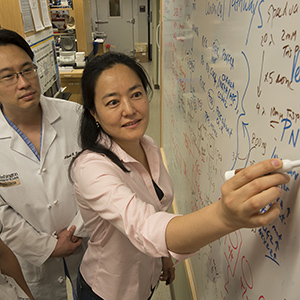Fatal cellular malfunction identified in Huntington’s disease

Robert Boston Hiroko Yano, PhD, right, led a team of researchers that learned how the fatal inherited disorder Huntington’s disease kills brain cells. Co-author Albert Kim also is pictured.
Huntington’s disease affects five to seven people out of every 100,000. Symptoms, which typically begin in middle age, include involuntary jerking movements, disrupted coordination and cognitive problems such as dementia. Drugs cannot slow or stop the progressive decline caused by the disorder, which leaves patients unable to walk, talk or eat.
Lead author Hiroko Yano, PhD, of Washington University School of Medicine in St. Louis, found in mice and in mouse brain cell cultures that the disease impairs the transfer of proteins to energy-making factories inside brain cells. The factories, known as mitochondria, need these proteins to maintain their function. When disruption of the supply line disables the mitochondria, brain cells die.
“We showed the problem could be fixed by making cells overproduce the proteins that make this transfer possible,” said Yano, assistant professor of neurological surgery, neurology and genetics. “We don’t know if this will work in humans, but it’s exciting to have a solid new lead on how this condition kills brain cells.”
The findings are available online in Nature Neuroscience.
Huntington’s disease is caused by a defect in the huntingtin gene, which makes the huntingtin protein. Life expectancy after initial onset is about 20 years.
Scientists have known for some time that the mutated form of the huntingtin protein impairs mitochondria and that this disruption kills brain cells. But they have had difficulty understanding specifically how the gene harms the mitochondria.
For the new study, Yano and collaborators at the University of Pittsburgh worked with mice that were genetically modified to simulate the early stages of the disorder.
Yano and her colleagues found that the mutated huntingtin protein binds to a group of proteins called TIM23. This protein complex normally helps transfer essential proteins and other supplies to the mitochondria. The researchers discovered that the mutated huntingtin protein impairs that process.
The problem seems to be specific to brain cells early in the disease. At the same point in the disease process, the scientists found no evidence of impairment in liver cells, which also produce the mutated huntingtin protein.
The researchers speculated that brain cells might be particularly reliant on their mitochondria to power the production and recycling of the chemical signals they use to transmit information. This reliance could make the cells vulnerable to disruption of the mitochondria.
Other neurodegenerative conditions, including Alzheimer’s disease and amyotrophic lateral sclerosis, also known as Lou Gehrig’s disease, have been linked to problems with mitochondria. Scientists may be able to build upon these new findings to better understand these disorders.
Funding from the National Institutes of Health (NIH) (R01 NS039324, R01 NS077748, K01 AG033724), the Huntington’s Disease Society of America (Coalition for the Cure), the Brain & Behavior Research Foundation, and the DSF Charitable Foundation supported this research.
Yano H, Baranov SV, Baranova OV, Kim J, Pan Y, Yablonska S, Carlisle DL, Ferrante RJ, Kim AH, Friedlander RM. Inhibition of mitochondrial protein import by mutant huntingtin. Nature Neuroscience, published online May 18, 2014.
Washington University School of Medicine’s 2,100 employed and volunteer faculty physicians also are the medical staff of Barnes-Jewish and St. Louis Children’s hospitals. The School of Medicine is one of the leading medical research, teaching and patient-care institutions in the nation, currently ranked sixth in the nation by U.S. News & World Report. Through its affiliations with Barnes-Jewish and St. Louis Children’s hospitals, the School of Medicine is linked to BJC HealthCare.
Media Contact
More Information:
https://news.wustl.edu/news/Pages/27042.aspxAll latest news from the category: Life Sciences and Chemistry
Articles and reports from the Life Sciences and chemistry area deal with applied and basic research into modern biology, chemistry and human medicine.
Valuable information can be found on a range of life sciences fields including bacteriology, biochemistry, bionics, bioinformatics, biophysics, biotechnology, genetics, geobotany, human biology, marine biology, microbiology, molecular biology, cellular biology, zoology, bioinorganic chemistry, microchemistry and environmental chemistry.
Newest articles

Silicon Carbide Innovation Alliance to drive industrial-scale semiconductor work
Known for its ability to withstand extreme environments and high voltages, silicon carbide (SiC) is a semiconducting material made up of silicon and carbon atoms arranged into crystals that is…

New SPECT/CT technique shows impressive biomarker identification
…offers increased access for prostate cancer patients. A novel SPECT/CT acquisition method can accurately detect radiopharmaceutical biodistribution in a convenient manner for prostate cancer patients, opening the door for more…

How 3D printers can give robots a soft touch
Soft skin coverings and touch sensors have emerged as a promising feature for robots that are both safer and more intuitive for human interaction, but they are expensive and difficult…





















